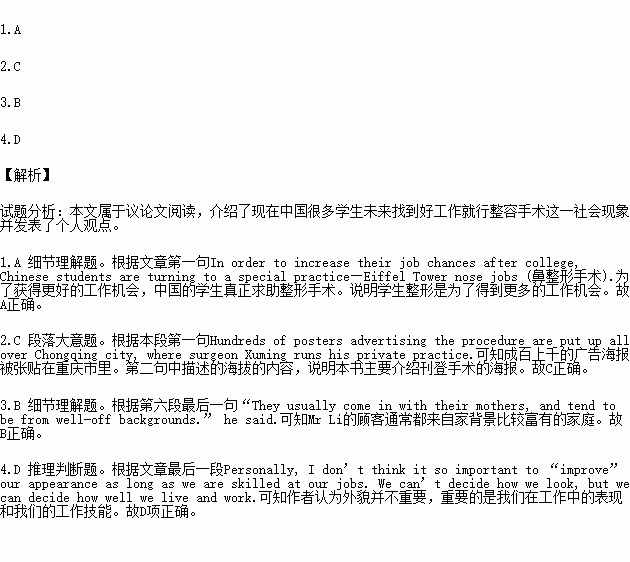题目内容
In order to increase their job chances after college, Chinese students are turning to a special practice—Eiffel Tower nose jobs (鼻整形手术). The latest trend in plastic surgery promises to create a nose that is similar to the curve of the Eiffel Tower.
Surgeon Wang Xuming said: “We are influenced by the beauty of the Eiffel Tower. We are not content to just add something to the nose; we reconstruct it.” The surgery costs about US$ 10,000 and involves the enlarging of the nose using tissue from the forehead.
Hundreds of posters advertising the procedure are put up all over Chongqing city, where surgeon Xuming runs his private practice. They show a western-looking woman with an almost-too-perfect nose, against an outline of the Eiffel Tower.
Interestingly, many young women in China are eager to achieve a western appearance, as they believe it will give them an advantage in the highly competitive job market. “Some students face a lot of employment pressure after graduation. If their facial features are good, they’ll have more chances of finding a job,” said surgeon Xuming. “We’ve had students getting the Eiffel Tower nose; it’s helped them a lot.”
Apparently, Chinese employers are quite particular about appearances and prefer attractive candidates. Some of them even go as far as putting height and weight requirements in their employment ads. Plastic surgeons across the country are reporting an increase in the number of students choosing beauty “improvement”.
According to a Mr. Li, hospital manager at surgeon Xuming’s clinic, most of their customers are female and the bill is taken care of by the family. “They usually come in with their mothers, and tend to be from well-off backgrounds.” he said.
Personally, I don’t think it so important to “improve” our appearance as long as we are skilled at our jobs. We can’t decide how we look, but we can decide how well we live and work.
1.Why do Chinese college students choose to have a nose operation?
A. To have more chances of getting a job.
B. To gain a real westerner appearance.
C. To Take good care of their family.
D. To look like the Eiffel Tower.
2.What is mainly talked about in Paragraph 3?
A. The city of Chongqing.
B. A plastic surgery procedure.
C. The posters advertising the surgery.
D. Xuming’s private practice.
3.What can we learn from Mr. Li’s words?
A. Most families can’t afford the expensive operation.
B. Their customers are usually from wealthy families.
C. Patients can be well looked after at the clinic.
D. The number of plastic surgeons is increasing.
4.Which of the following will the author probably agree with?
A. Chinese employers only care about their employees’ appearance.
B. Chinese students are content with the shape of their noses.
C. A western face looks prettier than a Chinese one.
D. Skills at work speak louder than appearance.

